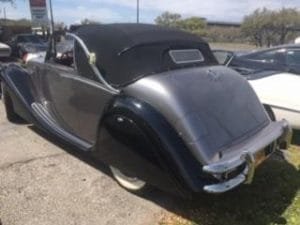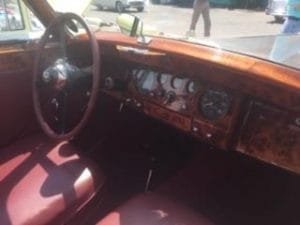Featured here is a great looking 1951 Jaguar Mark V Drophead Coupé. A very stylish luxury Jaguar. The Mark V replaced the Jaguar Mark IV which was produced from 1935-1939 and 1945-1948. The Mark IV’s were produced as 1.5, 2.5, 3.5 liter automobiles. The Jaguar Mark V continued with the overhead-valve pushrod straight-six engines with 2.5 and 3.5-liter displacements.
Prior to the war the Jaguars were built by SS Cars Ltd. Starting in 1945 the models were built under the name SS Jaguar.

The Mark V, introduced at the 1948 London Motor Show, was produced by Jaguar Cars Ltd of Coventry in England from 1948 to 1951. These were the first new postwar Jaguars.
The Jaguar Mark V Drophead Coupe
The Jaguar Mark V was available as a Drop Head Coupe and as a Saloon. The Drop Head Coupe was a two door convertible. The British early automakers used the word saloon denoting a four door sedan style. They took the word saloon which had been used for the luxury carriages on a train.
The 1948 Jaguar Mark V had many styling attributes taken from the prewar Mark IV’s. The car had a new design but the design still kept a prewar flavor. This included a large front grille that had a look similar to the Bentley. The Mark V’s had a rich look but not overdone. The headlights were flaring and the lines were like flowing wings.

The Mark V also had hydraulic brakes manufactured by Girling which was a British brake manufacturer noted for high quality. Girling used what was their patented wedge braking system. Wedge brakes essentially use a plunger to push a wedge between the brake rollers.
1951 Jaguar Mark V Specifications
The 1951 Jaguar Mark V was available with 152 and 213 cubic inch inline six Push Rod engines. Horsepower was 105 and 125 respectively. The Push Rod engines were used in the Jaguar Mark IV’s and V’s. Push Rod engines are overhead valve designed and are considered simpler (fewer parts lighter and smaller.
The Mk V had a top speed of 97 mph with 0-50 mph in 10 seconds and could maintain 80 mph or mor.
Transmission was a four speed manual.
Brakes were a four wheel hydraulic Girling wedge system.
Front suspension was comprised of a beam axle and half elliptic leaf spring. Rear suspension was a live axle with half elliptic leaf spring.
 Dimensions include an overall outside length of 187.5 inches. a 120.0 inch wheelbase, and a width of 69.5 inches. .
Dimensions include an overall outside length of 187.5 inches. a 120.0 inch wheelbase, and a width of 69.5 inches. .
Total Jaguar Mark V production during it’s entire run was about 10,500 vehicles.Drop head coupe total production was only 480 vehicles (another source claims about 900 were produced) either of which makes this model very rare.
Related Auto Museum Online articles are found on the links below..
Reference materials for this article includes..Jaguar Saloon Cars- The Push Rod Jaguars by Paul Skilleter..
1951 Jaguar Mark V Collector Values
 The Jaguar Mark V is a rare collector automobile whether it;s a Saloon or Drophead model. As mentioned, only about 10,500 total model were produces with dropheads comprising under 1,000.
The Jaguar Mark V is a rare collector automobile whether it;s a Saloon or Drophead model. As mentioned, only about 10,500 total model were produces with dropheads comprising under 1,000.
The Jaguar Mark V is an extremely rare luxury car and if you locate one you may find asking prices in the $60,000 to $100,000 area plus.
(Article and photos copyright Auto Museum Online)
